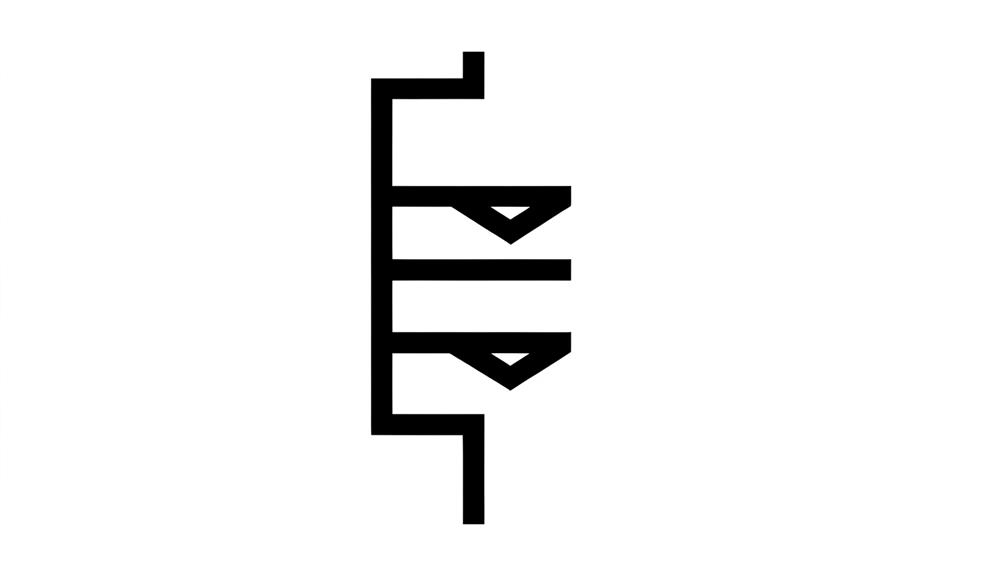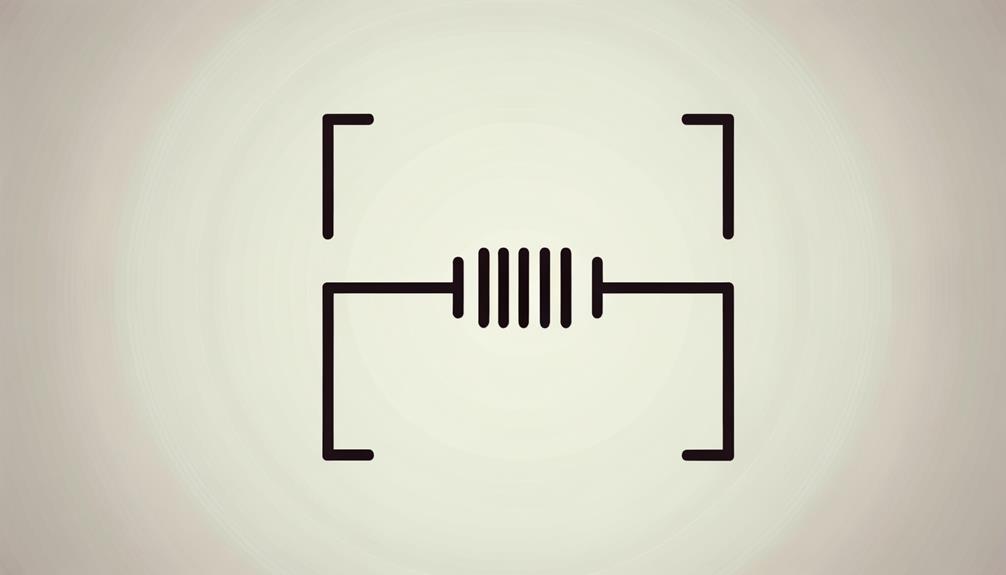How Does the Circuit Symbol for a Resistor Appear?
The circuit symbol for a resistor is vital in electrical schematics, denoting a component that impedes current flow. The standard symbol in American schematics is a zigzag line, while European schematics use a rectangular box.
Resistors can be fixed or variable, with the latter featuring an arrow through the symbol to indicate adjustable resistance. Accurate symbol usage guarantees clear communication and effective circuit analysis.
It is crucial for maintaining circuit functionality and troubleshooting. To understand the intricacies of resistor implementation and their role in various applications, further exploration is recommended.

Key Takeaways
- The resistor symbol in American schematics is a zigzag line.
- The resistor symbol in European schematics is a rectangular box.
- Fixed resistors are represented with a standard zigzag or rectangular box symbol.
- Variable resistors include an arrow through the standard resistor symbol.
- Proper resistor symbols ensure accurate and universal understanding in circuit diagrams.
Basic Resistor Symbol

The basic resistor symbol in schematic diagrams is represented by a zigzag line, denoting its function as a component that impedes electrical current flow. This symbol effectively communicates the resistor's role in providing resistance within an electrical circuit, controlling the current and voltage distribution.
Resistors are integral in managing energy dissipation, signal conditioning, and setting bias conditions in electronic circuits. By understanding this symbol, professionals can easily identify and implement resistors in circuit designs, ensuring accurate electrical performance.
The schematic representation focuses on simplicity and universal recognition, enabling engineers to rapidly interpret and construct complex circuits while maintaining clarity and precision. This foundational knowledge is critical for efficient circuit analysis and troubleshooting.
Types of Resistor Symbols
The representation of resistors in electrical schematics incorporates various symbols to denote their specific functionalities.
The standard resistor symbol, typically a zigzag or rectangular line, indicates a fixed resistance value.
In contrast, the variable resistor symbol features an arrow through the standard symbol, signifying an adjustable resistance, commonly found in potentiometers and rheostats.
Standard Resistor Symbol
In electrical engineering schematics, the standard resistor symbol is utilized to represent resistive components, with variations in design depending on regional standards such as the American zigzag line and the European rectangular box.
The American standard employs a series of jagged, triangular peaks resembling an oscillating wave, providing a clear visual indication of resistance. Conversely, the European standard adopts a simpler approach, using a rectangular box to denote resistive elements.
These symbols are integral in circuit diagrams, ensuring universal comprehension among engineers and technicians. Irrespective of the regional variation, each symbol signifies the presence of a component that impedes electrical current, thereby playing a critical role in the functionality and analysis of electronic circuits.
Variable Resistor Symbol
Variable resistors, also known as potentiometers or rheostats, are represented by symbols that incorporate an arrow intersecting the standard resistor symbol, indicating adjustable resistance levels within a circuit.
This arrow signifies the variable contact point on the resistive element, allowing for the fine-tuning of resistance values. Potentiometers typically feature a three-terminal configuration and are often used for voltage division applications.
Rheostats, on the other hand, usually have two terminals and are employed to adjust current flow. The precision of their graphical representation ensures that engineers can accurately interpret circuit diagrams.
Understanding these symbols is vital for designing and troubleshooting circuits, as variable resistors play a pivotal role in controlling electrical parameters dynamically.
American Vs. European Symbols

Distinguishing between American and European resistor symbols is essential for ensuring accurate schematic interpretation and cross-continental standardization in electronic circuit design. The American standard, as defined by ANSI, employs a simple zigzag line to represent resistors, reflecting the component's resistance to electric current. In contrast, the European standard, standardized by IEC, uses a rectangular box symbol.
These differences, though seemingly minor, are critical in preventing misinterpretation during international collaborations and manufacturing processes. Engineers must be proficient in recognizing and converting these symbols to maintain design integrity and functionality.
Additionally, understanding these symbol variations aids in the seamless integration of diverse components within global supply chains, ultimately enhancing efficiency and reliability in electronic system development.
Fixed Resistor Symbols
Fixed resistor symbols are essential to electronic schematic representation, serving as the standardized iconography to denote resistance in a circuit.
These symbols vary slightly between American and European standards but universally indicate a component designed to provide a specific, unchanging resistance.
Understanding the nuances of these symbols is vital for accurate schematic interpretation and effective circuit design.
Standard Resistor Iconography
Standard resistor iconography for fixed resistors mainly features two common symbols: a zigzag line used mainly in the United States and a rectangular box more frequently employed in European schematics. These graphical representations, standardized under IEEE and IEC guidelines, maintain consistency in electronic documentation.
Below are the key attributes of these symbols:
- Zigzag Line: This symbol highlights the resistive nature through undulating lines, visually indicating resistance.
- Rectangular Box: A simpler, minimalist form that is easily interpreted, in line with European design principles.
- Standardization: Both symbols conform to international standards, promoting global understanding and interoperability.
- Contextual Usage: Choice of symbol often depends on regional conventions and specific schematic design preferences.
Understanding these symbols is essential for accurate circuit interpretation and documentation.
Electronic Schematic Representation
In electronic schematics, fixed resistor symbols are vital for accurately conveying the resistance components within a circuit layout, ensuring precise communication of electrical design specifications.
The symbol most commonly employed is a zigzag line in North American standards, while the IEC (International Electrotechnical Commission) utilizes a rectangular box. Each symbol denotes a specific, unchanging resistance value, essential for maintaining circuit integrity.
These representations allow for clear interpretation by engineers, technicians, and designers, facilitating efficient troubleshooting and modifications. Understanding these symbols is crucial for interpreting circuit diagrams, ensuring that every component's role is unambiguously defined.
Mastery of these schematic representations underpins effective electrical engineering and electronics design, fostering seamless collaboration and innovation across the industry.
Variable Resistor Symbols

Variable resistor symbols are utilized to represent components like potentiometers and rheostats, which allow for adjustable resistance within electronic circuits. These symbols are essential in schematic diagrams for indicating where and how the resistance can be varied.
The most common symbols include:
- Potentiometer: Represented by a resistor symbol with an arrow pointing diagonally through it, signifying adjustable resistance.
- Rheostat: Illustrated as a resistor with an arrow pointing diagonally but without the third terminal, indicating variable resistance with only two connections.
- Digital Potentiometer: Often shown with a box and arrows, representing digital control over resistance.
- Preset Resistor (Trimmer): Depicted as a resistor with a horizontal line intersected by another line, indicating a variable resistor adjusted infrequently.
These symbols enable circuit designers to incorporate dynamic resistance control effectively.
Resistor Color Coding
Resistor color coding provides a standardized method for identifying the resistance value, tolerance, and sometimes reliability of resistors through a series of colored bands. Each color corresponds to a specific digit or multiplier, arranged in a precise sequence to denote the resistor's electrical characteristics.
Typically, a four-band code comprises two significant figures, a multiplier, and a tolerance indicator. For example, a resistor with bands of red, violet, yellow, and gold represents 27 x 10,000 ohms with a tolerance of ±5%.
Advanced coding schemes may include a fifth band for reliability or temperature coefficient. Understanding these codes is essential for accurate component selection and circuit design, ensuring that the resistors meet the required specifications and perform reliably under varying conditions.
Importance in Circuit Diagrams

Accurate resistor color coding is not only fundamental for component identification but also essential for interpreting and designing circuit diagrams effectively. Resistors are ubiquitous in electronic circuits, serving critical functions such as limiting current, dividing voltage, and setting time constants. Their correct representation guarantees that engineers can:
- Verify circuit functionality: By precisely depicting resistors, one can confirm the circuit behaves as intended.
- Facilitate troubleshooting: Clear resistor symbols assist in diagnosing and rectifying faults.
- Maintain design consistency: Uniform symbols promote standardization across schematics.
- Enhance communication: Precise circuit diagrams improve collaboration among engineering teams.
Understanding the role of resistors in circuit diagrams is indispensable for producing reliable and efficient electronic designs, thereby minimizing errors and enhancing overall system performance.
Common Mistakes to Avoid
In the field of circuit design, one frequently encounters several pitfalls that can compromise the integrity of resistor representation and functionality. A common error involves incorrect resistor symbol usage, leading to misinterpretations in schematic diagrams.
Additionally, not adhering to standardized notation, such as the IEEE or IEC symbols, can cause confusion. Another prevalent mistake is the omission of tolerance and power ratings, which are critical for ensuring reliable performance under varying operational conditions.
Moreover, misplacing resistors in circuit layouts can result in unintended circuit behavior, affecting overall system performance. Ensuring proper placement, accurate symbol usage, and clear notation is essential for maintaining the integrity and functionality of the designed circuits.
Precision in these aspects prevents costly errors and enhances circuit reliability.
Practical Applications

Utilizing resistors in practical applications spans a diverse array of functions, such as voltage regulation, current limiting, and signal conditioning, each essential for optimizing circuit performance. These components are indispensable in ensuring the reliability and efficacy of electronic systems.
Key practical applications include:
- Voltage Regulation: Resistors help maintain stable voltage levels across components, important for sensitive electronics.
- Current Limiting: They protect circuits by restricting excess current that could potentially damage other components.
- Signal Conditioning: Resistors shape and filter signals to meet specific criteria, necessary in analog and digital communications.
- Biasing of Transistors: Proper resistor values set the operating point of transistors, ensuring linear amplification and switching functionality.
These applications underscore the resistor's crucial role in modern electronics.
Conclusion
In the field of electrical engineering, the circuit symbol for a resistor emerges as an unparalleled cornerstone, its significance magnified by the intricate tapestry of symbols and color codes that dictate circuit diagrams.
The dichotomy between American and European representations, coupled with the nuanced distinctions of fixed and variable resistors, underscores its paramount importance.
Mastery of these symbols guarantees flawless circuit design and operation, while common pitfalls loom as colossal obstacles for the uninitiated.





